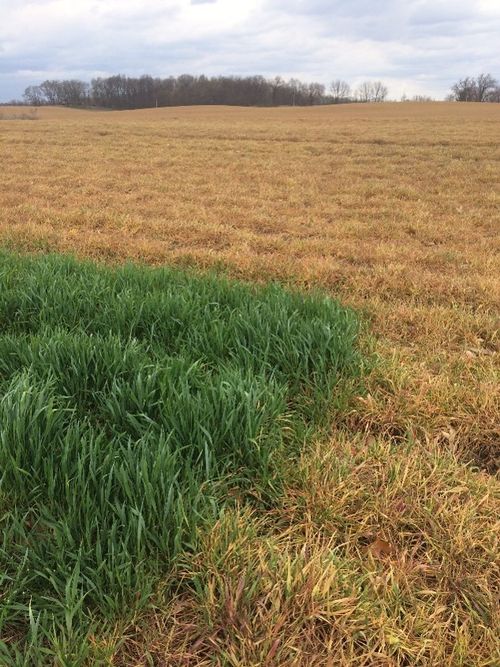Timing of cover crop termination can have significant benefits in wet and dry springs.

Early termination helps preserve seedbed soil moisture. If dry conditions are expected, then saving seed-zone moisture is critical. Once killed, the cover crop mulch should reduce evaporation from the soil surface. (Photo by Tony Vyn, Purdue University)
Timing of cover crop termination is one of the few management decisions that can be a benefit in either a wet or dry spring. An aggressive cover crop like cereal rye will use 0.8 inches of water per week in early April and increase to 1.2 inches of water per week by early May.
In the wet season, allowing the cover crop to grow to almost planting time can help dry fields and make them easier to work between rainfalls. In a dry spring, terminating the cover crop after a limited amount of growth stops the water use, yet leaves a dead cover to reduce water evaporation from the soil surface. Termination with herbicide rather than tillage maximizes the amount of water left in the soil.
Tony Vyn, professor of cropping systems in the Department of Agronomy at Purdue University, commented at a recent crop update meeting, “Early termination helps preserve seedbed soil moisture. If dry conditions are expected, then saving seed-zone moisture is critical. Once killed, the cover crop mulch should reduce evaporation from the soil surface. How much transpiration loss there is from a cover crop depends on its current biomass and the air temperatures going forward. The biggest risk is with fall rye that has a thick stand.”
The other advantage from early kill of a cereal cover crop before corn (e.g., 10 days to two weeks ahead of planting) is that there is less chance of negative allelopathic effects to early corn growth and a faster release of the nitrogen captured by the cover for the corn that follows.
Top irrigated crop producers manage cover crop growth closely. Even in fields where producers have irrigation available, early termination of the cover crop has an economic and water savings advantage. In a normal year, May rainfall is sufficient to replace the soil moisture used by the cover crop. However, in a dry spring, between the cover crop and tillage, irrigators may need to do 2 or 3 inches of additional irrigation applications to replace the water removed. At an average cost of $3.50 per acre-inch, the savings is over $10 in energy cost alone, not to mention the increase labor at a critical time of the year.


